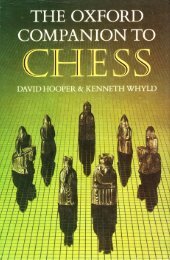Create successful ePaper yourself
Turn your PDF publications into a flip-book with our unique Google optimized e-Paper software.
232 OPEN SLAV DEFENCE<br />
lcgally possible. Wlire has a choicc of 20 Iirsr<br />
movcsi Blact the saoe number ofreplies, making<br />
400 differenl possiblc positions after one move<br />
each. In 1895 C. Flye St Marie calcllaled that<br />
7 I .852 difie rent legal posiiions we.e possi bl e atter<br />
two mo,es bv each pl.yer. This fie!.e is geometrically<br />
onect but in 1946 DAwsoN shosed that<br />
Wbile might have thc option oI an N p ssANr<br />
capture in 232 of these positions. depending on<br />
$hich ol about 200,000 differeni playing sequences<br />
were chosen. Frc6 a <strong>chess</strong> poinr oI view, therefore.<br />
?2,084 dificrent posirions are possible.<br />
Aiter three noves each morc than 9,000,000<br />
positionsarePossible. To arnve at every onc ofth.<br />
possible positions alter four moves each at the rate<br />
o<strong>to</strong>ne position aminul€ day and nightwolld take a<br />
player 600,000 years. Tbere a.e 2xlor possible<br />
difterent legal positions on a <strong>chess</strong>board. and ii<br />
bas been estimated that the nunber of distinct<br />
40 nove games is 25x10'8, far grealer than the<br />
eslimated number ol eledrons in ihc univeBe<br />
(10i). (For anolher asrronomical nsurc sec<br />
OPEN SLAV DEFENCE, 38. IhE<br />
'2!'! DEITNCE,<br />
OPEN TOURNAMDNTT a iournament tnat- nomi<br />
nallyatleasl, nas no reslriclion on entry. Tbns thc<br />
open chatuPionsbip ofa counlry nay be won <strong>by</strong> a<br />
non-rcsident.ln pradice entry <strong>to</strong> a! open rourna<br />
nent may dcpend on. ninimtrn levcl ofprolen<br />
OPPONENT, specidelly one who does not have<br />
the oove; generaly tbe adversary of atr idetriified<br />
OPmSITE COLOIIRED BISEOPS. see nrsH6pq<br />
OPPOSITION. a speci l relaiionship betwcen lhe<br />
positions ol thc kings pardy depe.ding on the<br />
distaDce belween them. rhe unil ol neasurenent<br />
is the dntance belween the centrcs of 1wo laterally<br />
adjoining squares. <strong>The</strong> kings stand in opposition<br />
when a) thc posilion is a zuczwANc and b) the<br />
co-ordinales of the distan.c betNeen the kings<br />
co.sisl of even nunbers as folloss: 2.0, dnect<br />
oprositionj 4,0, distant opposition: 6,0, lons'<br />
disranr opposirioni2.2. (v8) or 4,1, (v32) or6,6,<br />
(vr2), diaso.al oppositioni 2.4. (v20) or 2,6.<br />
(V4l) or a,6, (V52), oblique opposition. Tbe<br />
opposition may also be caled vertical lor kin8s<br />
standing on thc same nle, horizonlal for kin8s<br />
sranding on the samc rank. (Zugzwang is an ee<br />
s€nlialconsdtuenti yeirhetcrm opposiiion isofien<br />
misused<strong>to</strong>describeanysnuiiioninwhicbthekings<br />
stand as close as possible on lhe sane r.nk or file.)<br />
When lhe kings siand in opposition theplayerNho<br />
does nolhave rhe nove is said loosely<strong>to</strong> have the<br />
oppositioni ilhecreatessucb apositionheissaid<strong>to</strong><br />
take the oppositioni iI he dravs the gane <strong>by</strong><br />
maintaining the opposition hc is said 10 hale the<br />
oPoaENSKi, Karet (1892 197s), Czech player,<br />
lnternational Master (1950), International Arbi<strong>to</strong><br />
(1951), nalional ch<strong>amp</strong>ion 1929 and 1944. coch<strong>amp</strong>ion<br />
1927. 1938, and 19,13, civil seBanl. A<br />
nemberofthe Czech team in lour or.yMqADs from<br />
19311o 1939. he nade the best fourth-board score<br />
(+10=3) at Foltcsrone in 1933. His b€st rournamcnt<br />
achievemenr sas atBadsruben (stubnansk€<br />
Teplicc) 1930, sben he shared third prne wilh<br />
ELoHR and dr.c after LTLTENTSAL and prRc.In later<br />
life he <strong>to</strong>ok an adivc paft in cbeas organization.<br />
sening on several .rDr committees, and he was<br />
chiefa.bircr for the world ch<strong>amp</strong>ionship natches<br />
OPOaENSXi (iAMBIT, i32, ALEorN.\ name<br />
<strong>to</strong>r the BEN(o cAMBrr. beslowed alter oroaENsd<br />
had played it against rri.rurRG, Podebrady 1936.<br />
OPOaENSKi OPENiNG, 224, also known as rhe<br />
Tro6possly Ope.ing, played <strong>by</strong> JANows{ in the<br />
1920s, hy orcaENsKt in the l93os, and <strong>by</strong> his<br />
countryman troRr in the 1970s.<br />
OT,O.ENSKI VARIATION, ]81in the GR,NFELD<br />
D.mNcE as in the game Opoicnski-Pachman,<br />
P.ague 1947i264in the srduN D!lrN.E, an idca<br />
<strong>The</strong> kings sland in verti.al direct opposition.<br />
White <strong>to</strong> play draps: I Ke5 KeTz (z synboDes<br />
zugzwang) 2 Kd5 Kd?z 3k5Kcrz 4b5(Unablc<br />
<strong>to</strong> advane bis king White advances bis payn<br />
instead.)4. . . Kb7 5b6rb8 6Kc6Kcaz 7b7+<br />
(b82. Blackioplayloses: I ,Ke7 2(e5zKd? 3<br />
KdszKcT 4Kc5zKb7 5 (bszKa? 6Kc6(White<br />
mates ad outflanking mancuvre. ) 6 . . . Kb8 7 b5<br />
(a7 8 Kc7 Ka8 9 (66Kb8 10 Ka6 Ka8 1l b6z<br />
Kbs 12b7z.It isa. i. h erenl cha.acte sticofthis<br />
pa*n lomation (a single white pa*n al b4) that sir<br />
zuEzwangs are possible: theseoccurwirh the whire<br />
king on a5. b5. d, d5. e5, or f5 and the blackldng<br />
on a7 . b7 , cl , d1 , e7. o. l, respedivelr. <strong>The</strong>se<br />
reladonships may be shoNn thus a5=a?, b5=b7,<br />
and so on, each equarion representing a pan oi<br />
sqDares known as .oNruGAE souaREs, a term




